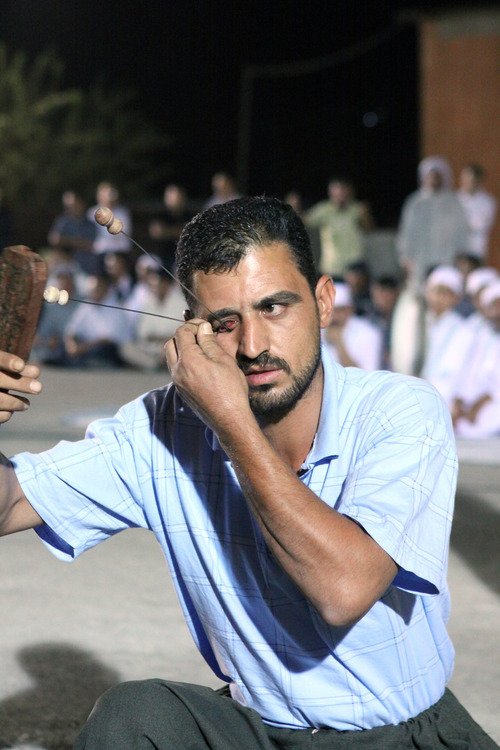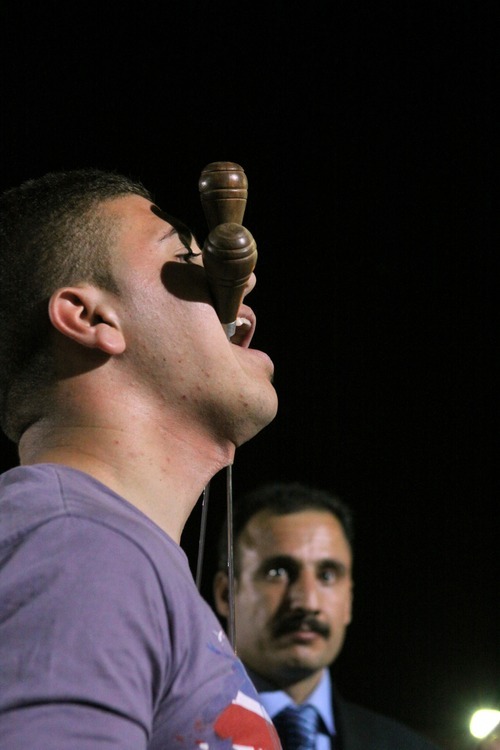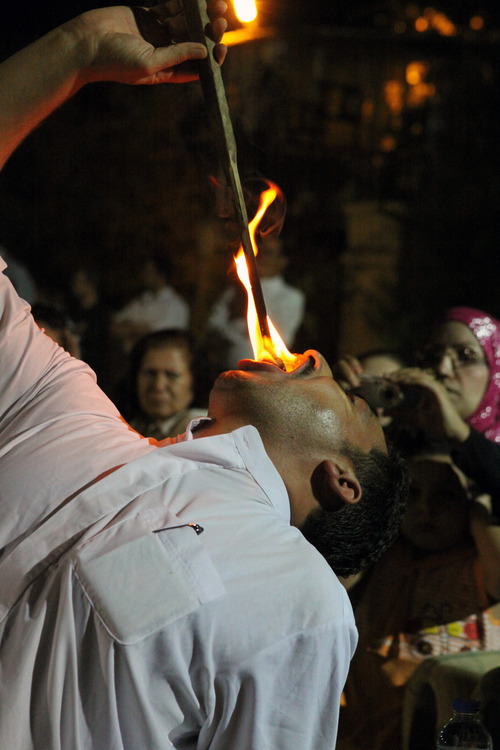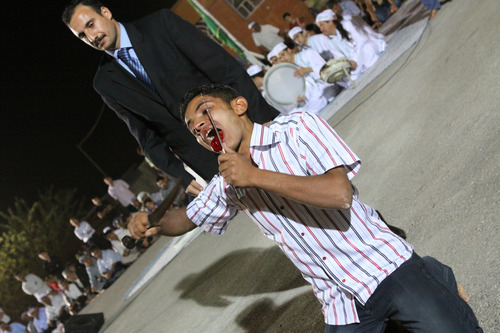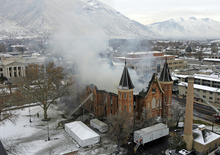This is an archived article that was published on sltrib.com in 2011, and information in the article may be outdated. It is provided only for personal research purposes and may not be reprinted.
Sulaymaniyah, Iraq • It began with a wild-eyed fire-eater. One by one, he dipped long, burning stakes down his throat. The flames spilled from his lips like lava oozing from a volcano.
That was the warm-up act.
A second man chomped down a 4-foot fluorescent light bulb as if it were a piece of celery, the tiny shards of glass dripping from his mouth in globs of blood. He was followed by a man who chewed up and swallowed a handful of razors with equally gory results.
There were a snake handler, a scorpion eater and a man who drove knives into his skull with a hammer. One subject placed a piece of burning coal in his mouth, which glowed orange like a jack-o'-lantern as he marched about the courtyard. A teenage boy stood stoically as an older accomplice drove several spikes through his cheeks and neck. Another man accepted a sword through his breast.
No one flinched.
Sunnis next to Shiites, Kurds next to Arabs, paupers and businessmen alike flock to this weekly revival, mutilating themselves as a sign of their devotion to God — and, they say, to prove his love for them.
"We know that one plus one is two, but when it is three, what do we know then? These men before you should have died," a self-proclaimed doctor told visitors at this heavily fortified compound, a part of Iraq's Kasnazani order of Sufi mystics. "What you have just witnessed is a miracle."
Ron Bradley, a Presbyterian chaplain from South Carolina, was unimpressed.
"That wasn't a miracle," he said of the two-hour spectacle he attended alongside other equally skeptical visitors from the United States. "Everything that happened here today can be explained by science, by anatomy, by reason."
But what cannot? In a world of ever-expanding scientific knowledge — in which events that once would have awed the world are now but a few clicks away from explanation — is anything a miracle?
And in a world where hockey games, football bowls, plane landings and even women's brassieres are "miracles" — is anything not?
It's been six months since the confluence of events that brought Bradley to this city in Iraq's predominantly Kurdish north and, on one warm Sunday evening, into the middle of this bloody ceremony. He is no more convinced now than he was then that what he witnessed was, in any way, a miracle.
At least not from his perspective. And, after some reflection, Bradley has come to believe that is an important distinction.
"Miracles are in the eye of the beholder," he said earlier this month from his home in Blythewood, S.C. "Take me, for instance. I've worked in hospital chaplaincy for 10 years, and I've seen people survive when basically they were given a death sentence. They go into remission. We take them off hospice. That, for me, is miraculous."
But even if God is working miracles in patients, Bradley said, it's not his place to proclaim it so.
"The scriptures talk about us being created in God's image, but I think that people want it to be the other way around," he said. "We're always trying to manipulate God — to ascribe to him things that we want to believe were his doing."
And most often, Bradley said, that's not for God's glory but for our own.
"What we're saying," he said, "is, 'Look at what God has done for me because of my faith.' I think that's very delusional."
'God's hand was definitely there'
The ashes of a four-alarm fire that destroyed the 127-year-old Provo Tabernacle were not yet cool last December when some members of The Church of Jesus Christ of Latter-day Saints began to focus their attention on a silver lining, of sorts. A painting of Jesus had been badly scorched in the blaze — save for Christ's image, which was left nearly untouched by the flames.
"A Christmas Miracle," Fox 13 News proclaimed on its Website, citing Rep. Jason Chaffetz, who told the Salt Lake City news station that he had seen the painting and "it really touched me, in a way — I was just absolutely amazed."
The charred painting, now in custody of the LDS Church, has not been seen publicly since the fire. But a number of photographs reportedly of the print have circulated online.
One picture came from a woman who identified herself as the wife of a Provo firefighter. "Share it with everyone," she wrote. "I think it's incredible and I'm sure others would love to see it, too. Even though it was a loss for many, God's hand was definitely there."
Not everyone was so impressed. Former Utahn Daniel Midgley, an ex-Mormon atheist who writes the blog Good Reason — goodreasonblog.blogspot.com — argued that those who find anything miraculous in the fire are "cherry-picking" the facts.
"One might wonder why the Mormon god would allow a church building to be destroyed by fire as he watches, pitiless and indifferent to human affairs," Midgley wrote. "One might even wonder what message he intends to send. Perhaps an Old Testament-style message of anger and vengeance! The fire and destruction symbolic of the wrath to come. … But wait! It's a Christmas miracle!"
In Midgley's view, those who saw God's hand in the scarred painting of Christ were using the same sort of broken logic that would allow some to see a "miracle" in a plane crash in which hundreds die and one person survives. Believers are quick to make such connections, Midgley wrote, "because in the face of disaster, there are only two possible outcomes — either your faith is boosted or your faith is boosted more. You have to admire their optimism, at least."
Other online skeptics reasoned that Christ's image, at the center of the painting, logically would take longer to burn than the rest of the print.
But LDS Church spokesman Scott Trotter believes miracles "are not defined by their scope, impact or transcendence of man's understanding of physical laws."
"Life by itself is a miracle: the birth of a baby, a dazzling sunset, twinkling stars on a dark, clear night," Trotter said. "All of these, and a great many others, may have practical explanations, but, ultimately, it is the divine intervention that constitutes the miracle. Even simple, everyday manifestations of God's power can be considered miraculous."
Trotter believes God "continues to perform miracles today. … They tell us that God loves us and that he is mindful of his children upon the Earth."
And the ability to see miracles in everyday life, he said, is most threatened by a "lack of faith."
'For a far greater purpose'
Bruce Stryd knows that some who share his faith are on the constant lookout for events and experiences they cannot explain, so that they can then "fill in the gaps" with God.
"Being trained as a scientist, I resist that," said Stryd, who double-majored in mathematics and natural sciences at Fresno Pacific University and now leads the Christian congregation at Pathway Community Church in Fremont, Calif. "But there are still some macro-questions — Where did it all come from? How did the rules of nature get started? — that beg the God question. I find that, though it is true that human knowledge keeps explaining more and more, the answers often lead to bigger and more questions."
Stryd, who weighs in on the miraculous and the mundane alike at Bruce's Bible Blog — brucebible.blogspot.com — said people don't have to toss away their scientific skepticism to accept a personal God who works in personal ways.
"When someone experiences an incredible change in life, attitude, perseverance, healing or perspective," Stryd said, "this can be a miracle to the person, no matter how down-to-earth, because the result is so life-changing."
Where should believers set the bar?
Dan McKinney, pastor of Westside Presbyterian Church in Salt Lake City, thinks it should be set high.
"A lot of the things we call miracles aren't miracles," McKinney said. "When a baby is born, that's not a miracle. When a parking spot suddenly opens up when we really need one, that's not a miracle."
In the Bible, McKinney notes, God performs miracles to save an entire nation — such as when he helps Moses part the Red Sea so the Israelites can escape Egypt.
"When God intervenes," McKinney said, "he doesn't do it on behalf of an individual, he does it for a far greater purpose."
Even the personal miracles ascribed to Jesus in the Christian New Testament — healing the sick and raising the dead, for instance — are not done on behalf of individuals so much as to demonstrate God's power, McKinney said.
And Imam Muhammed Mehtar agrees that is the proper context for miracles to occur. He believes miracles are not intended for personal gain — even personal spiritual gain — but rather for the benefit of observers to better understand God.
"Our religion tells us that God has given the ability to some people to do miracles," said Mehtar, principal of the Khadeeja Islamic Center in West Valley City. "But if this were to happen to you, you should not go about trying to perform miracles. That shifts the focus from God to you, and that is wrong. And for those of us that are in the masses, those who cannot do miracles, we should not go about looking for miracles. That is quite selfish. The idea of believing is to give yourself to God without condition."
Rabbi Ilana Schwartzman has room in her heart and her mind for the miraculous. From human consciousness to the mathematical perfection of the universe, and even the very chemicals that course through the veins of those who mutilate themselves to find God — "to a certain degree, I think, it is miraculous that we have adrenaline," she said — Schwartzman believes there are miracles.
But the rabbi, who was installed as leader of Congregation Kol Ami in Salt Lake City earlier this year, doubts God performs individual miracles on behalf of only some of his children.
"There's a certain amount of arrogance involved in expecting a miracle in our own life," she said, "and not expecting them in others."
Schwartzman's line of work brings her into frequent and intimate contact with those seeking God's intervention in their lives. But instead of miracles, Schwartzman said, she tells congregants "to pray as if everything depends on God and act as though everything depends on you."
And when good things happen, she said — even good things that defy explanation — "there is a way of feeling blessed without feeling as though it was miraculous."
While no one faith appears to have a corner on the miracle market, the Roman Catholic Church certainly pours more time into investigating the subject than most, partly because of the Vatican's requirement that those being considered for sainthood be associated with two miracles.
"Doctors are consulted, scientists, psychologists, psychiatrists," explained Monsignor Francis Mannion, pastor of St. Vincent de Paul Catholic Church in Holladay. "If they say that none of these things can explain what has occurred, then the church is more apt to validate something as a miracle."
The ever-expanding breadth of human knowledge moves the bar higher and higher, Mannion said. "We live in a culture which is more rationalistic and not given easily to belief in miracles. And I would say that's not a problem. If a miracle occurs, then hopefully you'll recognize it, but if you don't, I'm not going to try to talk you into it."
After all, he said, no one should need a miracle to believe in God or to feel his hand in their lives.
'Let it into your life'
Only a small number of the world's Sufis engage in body-mutilation rituals. And Devi Tide, leader of the Sufi Healing Order of North America, isn't among them.
"I'm too squeamish," Tide said with a laugh. "I'll leave that to them."
But Tide said she honors any way in which people are able to feel a divine effect in their lives. For her, too, miracles are in the eye of the beholder.
She recalled a time at a conference with other members of her order when one of the event's leaders received a telephone call from his doctor. The man excused himself from the conference, telling others that he had been diagnosed with cancer and would need to have surgery.
"After he left, we decided to do a prayer," Tide said. "And so we all took about 15 minutes, maybe 20 minutes and we did a ceremony for this person — a healing circle."
After the group returned from lunch, Tide said, the man was back. His doctor, after consultation with other physicians, had decided that he had misread the test results. There would be no need for surgery.
"So that was certainly a fortuitous turn of events," Tide said. "But do we want to call that a miracle?"
Tide said she doesn't need a label for life's favorable happenstances. For her, she said, it is enough to know that sometimes things happen "that cause people to think about what they might be taking for granted in their lives — they were having a hard time, they cried out for help in some way, and somehow they received the help they needed."
If someone perceives that as a miracle, she said, that's fine.
"What I say to them is that you need to be willing to witness what has happened, to accept it and let it into your life," she said. "We should take a minute and be at peace with the way life changes. And we should honor that and accept it and then not make such a big thing out of it."
What about you?
Have you experienced a miracle? Have you seen one in the life of others? Do you have an experience that you cannot explain, but which you are unwilling to call a miracle? Join the discussion below. Miracle or Not? Take the Poll:


